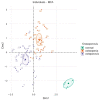Vitamin D Deficiency in Women with Breast Cancer: A Correlation with Osteoporosis? A Machine Learning Approach with Multiple Factor Analysis
- PMID: 35458148
- PMCID: PMC9031622
- DOI: 10.3390/nu14081586
Vitamin D Deficiency in Women with Breast Cancer: A Correlation with Osteoporosis? A Machine Learning Approach with Multiple Factor Analysis
Abstract
Breast cancer (BC) is the most frequent malignant tumor in women in Europe and North America, and the use of aromatase inhibitors (AIs) is recommended in women affected by estrogen receptor-positive BCs. AIs, by inhibiting the enzyme that converts androgens into estrogen, cause a decrement in bone mineral density (BMD), with a consequent increased risk of fragility fractures. This study aimed to evaluate the role of vitamin D3 deficiency in women with breast cancer and its correlation with osteoporosis and BMD modifications. This observational cross-sectional study collected the following data regarding bone health: osteoporosis and osteopenia diagnosis, lumbar spine (LS) and femoral neck bone mineral density (BMD), serum levels of 25-hydroxyvitamin D3 (25(OH)D3), calcium and parathyroid hormone. The study included 54 women with BC, mean age 67.3 ± 8.16 years. Given a significantly low correlation with the LS BMD value (r2 = 0.30, p = 0.025), we assessed the role of vitamin D3 via multiple factor analysis and found that BMD and vitamin D3 contributed to the arrangement of clusters, reported as vectors, providing similar trajectories of influence to the construction of the machine learning model. Thus, in a cohort of women with BC undergoing Ais, we identified a very low prevalence (5.6%) of patients with adequate bone health and a normal vitamin D3 status. According to our cluster model, we may conclude that the assessment and management of bone health and vitamin D3 status are crucial in BC survivors.
Keywords: bone mineral density; breast cancer; cluster analysis; machine learning; multiple factor analysis; osteoporosis; vitamin D.
Conflict of interest statement
The authors declare no conflict of interest.
Figures




Similar articles
-
Bone density in Moroccan women with systemic scleroderma and its relationships with disease-related parameters and vitamin D status.Rheumatol Int. 2012 Oct;32(10):3143-8. doi: 10.1007/s00296-011-2150-1. Epub 2011 Sep 27. Rheumatol Int. 2012. PMID: 21947376
-
Evaluation of Serum 25-Hydroxyvitamin D3 and Bone Mineral Density in 268 Patients with Hip Fractures.Orthop Surg. 2021 May;13(3):892-899. doi: 10.1111/os.12920. Epub 2021 Mar 30. Orthop Surg. 2021. PMID: 33783959 Free PMC article.
-
Oral Health in Breast Cancer Women with Vitamin D Deficiency: A Machine Learning Study.J Clin Med. 2022 Aug 9;11(16):4662. doi: 10.3390/jcm11164662. J Clin Med. 2022. PMID: 36012901 Free PMC article.
-
Effect of supplemental vitamin D3 on bone mineral density: a systematic review and meta-analysis.Nutr Rev. 2023 Apr 11;81(5):511-530. doi: 10.1093/nutrit/nuac068. Nutr Rev. 2023. PMID: 36308775
-
Osteoporosis and multiple sclerosis: Exploring the complex intersection between bone and brain, a clarion call for change.Mult Scler Relat Disord. 2025 Jun;98:106420. doi: 10.1016/j.msard.2025.106420. Epub 2025 Apr 1. Mult Scler Relat Disord. 2025. PMID: 40203605 Review.
Cited by
-
Vitamin D for Clinical Diseases in Women: An Indispensable Factor in Medicine and Dentistry.J Clin Med. 2022 May 30;11(11):3104. doi: 10.3390/jcm11113104. J Clin Med. 2022. PMID: 35683491 Free PMC article.
-
Confronting the global obesity epidemic: investigating the role and underlying mechanisms of vitamin D in metabolic syndrome management.Front Nutr. 2024 Aug 9;11:1416344. doi: 10.3389/fnut.2024.1416344. eCollection 2024. Front Nutr. 2024. PMID: 39183985 Free PMC article. Review.
-
Effects of Selective and Nonselective Beta Blockers on Bone Mineral Density in Mexican Patients with Breast Cancer.Cancers (Basel). 2024 Aug 20;16(16):2891. doi: 10.3390/cancers16162891. Cancers (Basel). 2024. PMID: 39199661 Free PMC article.
-
Efficacy of Transcranial Direct Current Stimulation (tDCS) on Balance and Gait in Multiple Sclerosis Patients: A Machine Learning Approach.J Clin Med. 2022 Jun 17;11(12):3505. doi: 10.3390/jcm11123505. J Clin Med. 2022. PMID: 35743575 Free PMC article.
-
Vitamin D and curcumin-loaded PCL nanofibrous for engineering osteogenesis and immunomodulatory scaffold.Front Bioeng Biotechnol. 2022 Aug 8;10:975431. doi: 10.3389/fbioe.2022.975431. eCollection 2022. Front Bioeng Biotechnol. 2022. PMID: 36003534 Free PMC article.
References
-
- Montagnese C., Porciello G., Vitale S., Palumbo E., Crispo A., Grimaldi M., Calabrese I., Pica R., Prete M., Falzone L., et al. Quality of Life in Women Diagnosed with Breast Cancer after a 12-Month Treatment of Lifestyle Modifications. Nutrients. 2020;13:136. doi: 10.3390/nu13010136. - DOI - PMC - PubMed
-
- Paolucci T., Saggino A., Agostini F., Paoloni M., Bernetti A., Mangone M., Santilli V., Saggini R., Tommasi M. The influence of rehabilitation on quality of life in breast cancer survivors: A clinical study. Int. J. Environ. Res. Public Health. 2021;18:8585. doi: 10.3390/ijerph18168585. - DOI - PMC - PubMed
-
- Waqas K., Lima Ferreira J., Tsourdi E., Body J.J., Hadji P., Zillikens M.C. Updated guidance on the management of cancer treatment-induced bone loss (CTIBL) in pre- and postmenopausal women with early-stage breast cancer. J. Bone Oncol. 2021;28:100355. doi: 10.1016/j.jbo.2021.100355. - DOI - PMC - PubMed

